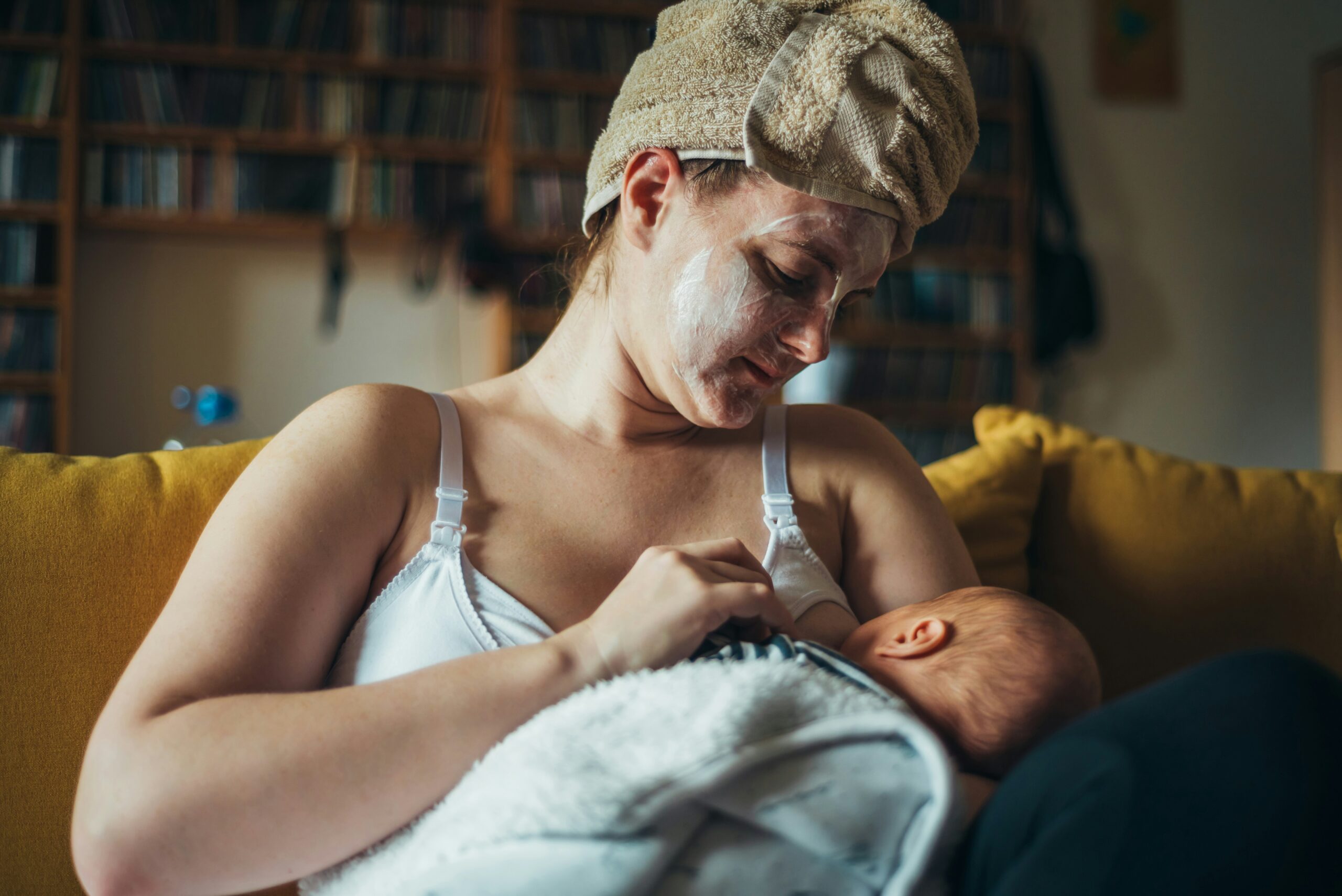Whether you’re breastfeeding or pumping, a newbie or seasoned pro, nipple cream is going to be your new BFF. Breastfeeding can open up a pandora’s box of challenges, but one of the most common issues is the discomfort and pain that our nipples endure while trying to provide for our children.
I exclusively pumped for three months, which brought on many challenges. Before finding the proper flange size, I was experiencing extreme discomfort and sensitivity, which was relieved only when my lactation consultant recommended using nipple cream before and after each pumping session.
And wow, did it make a difference.
Nipples, like the rest of our skin, depend on moisture to maintain integrity, which can be compromised with multiple breastfeeding sessions. When the skin becomes dry, it can easily crack and become damaged, which is where nipple cream comes in clutch majorly to help resort and maintain moisture.
Nipple cream can come to the rescue as you work through
challenges with your baby’s latch, or just dealing with chafing, soreness, or discomfort while breastfeeding or pumping, providing you with soothing relief.
Here’s a deep dive into why nipple cream for breastfeeding is going to save your nips and what to look for when choosing the perfect companion for your breastfeeding adventure.
What to look for in Nipple Cream for Breastfeeding:
When I started my breastfeeding journey nine months ago I thought my nipples were going to fall off my body. They were so sensitive and sore. That’s when lactation consultant Tiffany Haddad MSN, AGPCNP-BC, IBCLC of Milk Body Soul stepped in and helped me become (semi) comfortable with exclusively pumping.
When selecting a nipple cream for breastfeeding, there are several factors that Haddad recommends considering to ensure it meets your needs effectively and safely.
- Ingredients: Check the ingredient list for safe and hypoallergenic components. Many moms prefer lanolin-based creams, as they closely resemble the skin’s natural oils. Take into account any allergies or sensitivities you or your baby may have. If you have a history of skin allergies, consider doing a patch test before applying the cream to your nipples.
- Safety: Haddad recommends making sure the nipple cream is safe for your baby to ingest. “If you’re wiping the cream off before or after breastfeeding you can cause more damage to the sensitive skin.” To avoid further damage, look for cream that can stay on during each feeding session. You should avoid ingredients babies can’t ingest like petroleum jelly and Vitamin E.
- Ease of Application: No one wants to apply a cream that requires warming or additional steps during a 3 a.m. feeding. To streamline the process, look for a cream with a texture that you find easy to apply. Creams that are too thick may require warming between your fingers before use, while others may have a smoother, easy-to-spread consistency.
Tubby Todd Nipple Balm Bundle
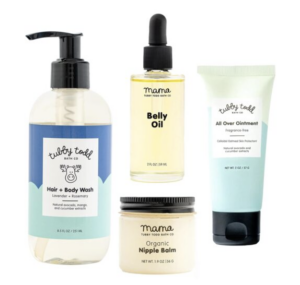
Tubby Todd Nipple Balm is a gentle, lanolin-free balm that helps to prevent and restore cracked and dry nipples while you’re nursing. Made with coconut oil, aloe, and calendula, this calming balm soothes and protects tender skin, and is safe for you and your baby to use before, during, and after nursing. This bundle also provides you with lavender hair and body wash, a fragrance-free all over ointment and a belly oil.
One mom received this at her baby shower and it became one of her most used products after her baby came. “A co-worker gave me this to me at my shower and told me it would be life changing if I went on a breastfeeding journey, and she was not wrong. This cream worked quickly to relieve discomfort in the early days.” Jess, Mom of one. shared. “I also loved how compact it was so I could easily put it in my pocket to use when I left the house.”
What we love:
- Gentle on sensitive and tender skin.
- No need to wash it off before or after breastfeeding.
- Moisturizes and reduces friction during pumping.
What we would change:
- Would like to see a thicker consistency.
Quick Facts:
- Ingredients: Cocos Nucifera (Coconut) Oil*, Helianthus Annuus (Sunflower) Oil*, Cera Alba (Beeswax)*, Olea Europaea (Olive) Fruit Oil*, Butyrospermum Parkii (Shea) Butter*, Aloe Barbadensis Leaf*, Calendula Officinalis Flower Oil* *Certified organic ingredients
- Size: 1.9 oz
Buy now on Amazon; $69.00
Bodily Nip Duo
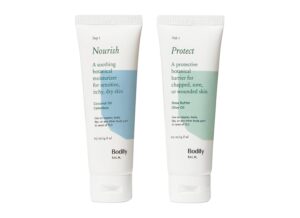
This natural and organic skincare duo relieves dry or cracked nipples and helps soothe the wear and tear from breastfeeding. It’s packed with oils and plant-based ingredients and super gentle on your skin so you can even use it on other areas that need some extra care.
Start with ‘Nourish’ to hydrate and make your skin supple, and then seal the deal with ‘Protect,’ a plant-based alternative to lanolin that shields your skin.
What we love:
- Compact size allows you to easily travel with the creams.
- Soothes nipples quickly.
- Clean ingredients so there isn’t any guesswork in quality.
What we would change:
- Pricey for the amount of cream you receive.
Quick Facts:
- Ingredients: Nourish: Organic Coconut Oil, Organic Jojoba Seed Oil, Beeswax, Calendula, Calendula Flower Extract, Caprylic/Capric Triglyceride. Protect: Shea Butter, Organic Olive Fruit Oil, Organic Coconut Oil, Caprylic/Capric Triglyceride, Calendula Flower Extract, Beeswax, Tocopherol.
- Size: Nip Nourish .5 oz. Nip Protect .5 oz.
Buy now on Amazon; $15
Lansinoh Lanolin Nipple Cream
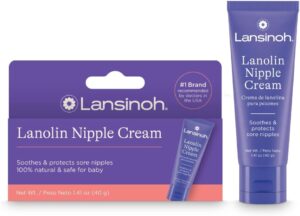
Often distributed by hospitals, this nipple cream is 100 percent natural and safe for both you and your baby as it contains no additives, preservatives, or harmful chemicals. This means you don’t have to remember to remove it before nursing your baby. The cream is designed to provide instant relief and protection to sore and cracked nipples and has a smooth and easy-to-apply texture, making it hassle-free.
I exclusively pumped for three months and this was the cream that got me through the early days when I thought my nipples might fall off my body. Before I found the proper flange size for my pump (which was a big hurdle), my nipples were extremely sore and sensitive after each pump session and this cream helped soothe and eliminate friction.
What we love:
- Gentle on sensitive, tender skin.
- No need to wash it off before breastfeeding.
- Squeeze tube allows you to access cream with limited mess.
What we would change:
- Can stain clothing or bra if not removed after use or covered with nipple pads.
Quick Facts:
- Ingredients: 100% natural, ultra-purified lanolin
- Size: 1.4 oz
Buy now on Amazon; $11
Earth Mama Nipple Butter
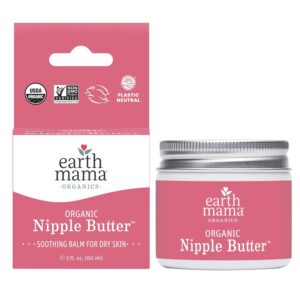
Truly a mom-favorite — this nipple cream is packed with USDA-certified organic ingredients, making it super safe and natural. It’s great for soothing and healing sore nipples during breastfeeding and works fast. Plus, it’s not just for nipples – you can use it on lips, cheeks, heels, or anywhere that needs some extra love.
One friend used this cream on her nipples before her baby was born and loved it so much that she still uses it. “I started applying daily around 36 weeks pregnant and continued for the first 3 months of my breastfeeding journey and I barely experienced any issues with cracking or pain – I even used it as a lip balm when my lips were dry and cracked,” Melissa, Mom of one who exclusively breastfed for three months, shared.
What we love:
- Quick relief after application.
- Absorbs into skin easily.
- Ingredients are organic and natural, making it safe for mom and baby.
What we would change:
- Can stain clothing or bra if not removed after use or covered with nipple pads.
Quick Facts:
Ingredients: Organic Olive (Olea Europaea) Fruit Oil, Organic Beeswax (Cera Flava), Organic Cocoa (Theobroma Cacao) Seed Butter, Organic Shea (Butyrospermum Parkii) Butter, Organic Mango (Mangifera Indica) Seed Butter, Organic Calendula (Calendula Officinalis) Flower Extract
Size: 2 fl oz
Buy now on Amazon; $14
Motherlove Nipple Cream
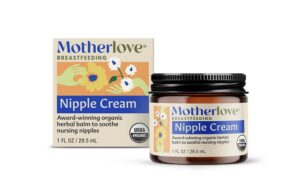
Plant-based and certified organic, Motherlove nipple cream was designed to provide relief and care for chaffed and cracked nipples. The nipple cream absorbs quickly into your skin to provide instant relief. It contains simple ingredients, including marshmallow root which is considered to be extra soothing.
If you’re someone who also pumps, Haddad recommends this as a lubricant for your flanges. The olive oil helps relieve any friction.
What we love:
- Can be used on any dry skin.
- No need to wash it off before breastfeeding.
- Great lubricant for pumping.
What we would change:
- Provide longer relief.
Quick Facts:
- Ingredients: Extra virgin olive oil*, beeswax*, shea butter*, marshmallow root*, calendula flower*. Clinically Tested to Not Cause Irritation. (*Certified Organic by Oregon Tilth)
- Size: 1 fl oz
Buy now on Amazon; $13
Coconut Oil
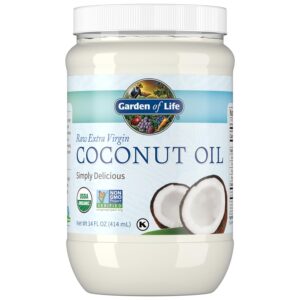
One of Haddad’s favorite nipple creams is something you might already have in your pantry — coconut oil. “I love the simple ingredients and most of us already have it in our homes,” Haddad says. “If you have cracked nipples, the coconut oil will quickly repair damage and help soothe during your breastfeeding sessions.”
To help retain its healing properties, opt for unrefined, organic, raw coconut oil because it retains the most healing properties in that state.
What we love:
- Simple, clean ingredients.
- Versatile product.
- Has healing properties to help repair skin.
What we would change:
- Application can be messy.
Quick facts:
- Ingredients: Organic Expeller Cold-Pressed Coconut Oil.
- Size: 14 fl oz
Buy now on Amazon; $10
Nipple Crack Nipple Balm
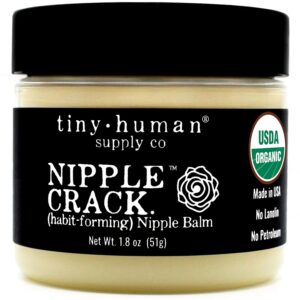
Made from seven premium organic ingredients, this small but mighty nipple cream works wonders on cracked and sore nipples. It is easy to apply and absorbs quickly, providing long-lasting relief. The balm also helps to protect the nipples from further damage.
A little goes a long way – simply scoop a little out and apply to the sensitive skin. Haddad recommends warming the cream or balm between your fingers slightly for a smoother application.
What we love:
- No need to wash off before breastfeeding.
- Doesn’t leave a residue on clothing.
- Fast relief.
What we would change:
- Balm can get stuck under nails when dispensing.
Quick facts:
- Ingredients: Cocos Nucifera (Coconut) Oil, Helianthus Annus (Sunflower) Seed Oil, Cera Alba (Beeswax), Oleas Europea (Olive) Fruit Oil, Butyrospermum Parkii (Shea) Butter, Aloe Barbadensis (Aloe) Leaf Juice, Calendula Officinalis (Calendula) Flower Oil
- Size: 1.8 oz
Buy now on Amazon; $13
Mommy’s Bliss Lanolin Nipple Balm
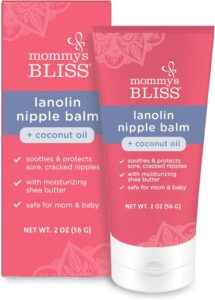
This lanolin-based nipple balm is designed to relieve and protect your nipples with lanolin, coconut oil, plus moisturizing shea butter. When applied before breastfeeding, it will create a protective barrier on your nipples, to soothe your tender skin.
One mom I spoke to was experiencing horrible nipple cracking, bleeding and sensitivity and this is the only cream that worked quickly to relieve her pain. “Hands down the best nipple cream I’ve used. I’ve tried almost every other brand, but this one was different,” Alyssa says. “It glides on so smoothly, which really helped when my nipples were extremely sensitive and sore.”
What we love:
- Squeeze bottle allows for mess-free application.
- No need to wash off prior to feeding.
- Quickly relieves dryness.
What we would change:
- Requires warming between fingers before application.
Quick facts:
- Ingredients: Lanolin, Butyrospermum parkii (Shea) Butter, Cocos nucifera (Coconut) Oil.
- Size: 2 oz
Buy now on Amazon; $11
One Last Thing: FAQ
How do I use nipple cream?
To help soothe sore and cracked nipples and prevent further harm, Haddad suggests following these steps.
- Choose a safe and appropriate nipple cream that is safe for both you and your baby. Many nipple creams are designed to be safe for breastfeeding and do not require removal before nursing. Read the label to ensure it is safe for your situation.
- Gently apply the cream to your nipple and the surrounding area before breastfeeding or pumping. Be sure to cover any areas that are sore, cracked, or irritated.
- For additional relief, apply the nipple cream after each breastfeeding session. This helps keep your nipples moisturized and protected.
Does nipple cream really work?
Nipple cream is often used by breastfeeding mothers to soothe and protect their nipples, which can become sore and cracked due to frequent nursing or pumping. Nipples, like the rest of our skin, depend on moisture to maintain integrity. The drier the skin, the more easy it is to crack and become damaged. Using a nipple cream helps restore the moisture in the affected area and helps repair any current damage.
How often should I apply nipple cream?
The frequency of applying nipple cream can vary depending on your individual needs and the specific nipple cream you are using. Most commonly, Haddad suggests for her moms to apply before and after each feeding until they are in a place of comfort.
Many moms (including myself) find it helpful to apply before taking a shower. I remember showering backward for a few weeks because the water hitting my chest would irritate my nipples. The warm water during the shower can soften the skin, and the cream can act as a protective barrier.
What do I do if nipple cream isn’t providing relief?
If you find that you are experiencing persistent discomfort, soreness, or cracked nipples despite using nipple cream, it’s a good idea to consult with a lactation consultant or a healthcare professional. They can provide personalized advice and may help identify any underlying issues that need to be addressed to improve your breastfeeding experience.
Author
-

Zoe Roscoe Bridgeman has a decade of experience crafting captivating content in the fashion, travel, and lifestyle space for several online publications, including Bilt Rewards, Apartment Therapy, BuzzFeed and more. When she's not busy writing, she loves to cook, try new workout classes and travel with her son and husband. Getting comfortable with the uncomfortable is her approach to life, which has been helpful in her journey into motherhood.
View all posts

